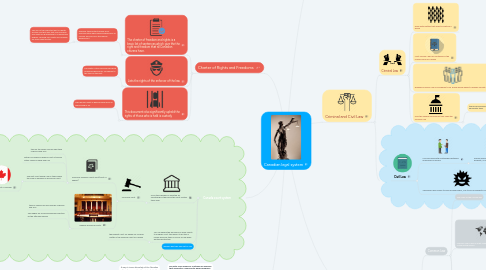
1. Charter of Rights and Freedoms
1.1. The charter of freedom and rights is a basic list of sentences which give the the right and freedom that all Canadian citizens have.
1.1.1. example: they protect people from discrimination when being employed by or receive services from the federal government
1.1.1.1. The one of the important part is charter section one that says that your freedom and rights are guaranteed to a reasonable degree. Meaning your rights and freedom are some what limited.
1.2. Lists the rights of the enforcer of the law
1.2.1. The rights of the Law enforcers have dropped significantly. Compared to the times in the past.
1.3. This document also significantly upheld the rights of those who is held is custody
1.3.1. Their human rights in general have gone up while being in jail.
2. Canada court system
2.1. Once the individual is arrested for something by the police the court system takes over
2.1.1. Provincial court
2.1.1.1. Provincial supreme courts AKA(court of appeal)
2.1.1.1.1. take on the cases such as indictable offences and ETC.
2.1.1.1.2. British Columbia's supreme court is tried by either judge or judge and jury
2.1.1.1.3. The next court which case is taken when the case is appealed in provincial court.
2.1.1.2. Regular provincial courts
2.1.1.2.1. take on cases such as summary offenses and ETC.
2.1.1.2.2. The judges are recommended and elected by the attorney general
2.2. You can appeal the decisions of lower courts to a higher court. the reason to do this is usually because there is a error of law while sentencing the trial.
2.2.1. the highest court for appeal for criminal matter is the supreme court of Canada
2.3. Quebec has their own set of rule
3. Penal system
3.1. Recently more known as a network of agencies that administer a community-based programs like parole and probation boards to help the offenders to be able to fit in to community.
3.1.1. A way to insure the safety of the Canadian citizen because when the criminals join the society the crime rate has dropped.
3.2. The prison system of Canada
3.2.1. Working camps with law security to high maximum security prisons
3.3. Is handed over after being sentenced guilty by the court system
3.4. A system with the government designed to punish people who have done wrong
4. Criminal and Civil Law
4.1. Criminal Law
4.1.1. Deals with matters that affect society as a whole
4.1.2. Most criminal laws are contained in the criminal code of Canada
4.1.3. Breaking Criminal Law is considered to be doing wrong against Canadian Society
4.1.3.1. criminal cases are carried out in the name of crown.
4.1.4. Only the Federal Government can make the Criminal Law
4.1.4.1. the provincial government can only help to administer them
4.2. Civil Law
4.2.1. Civil law deals with relationships between individuals or groups.
4.2.1.1. usually involve disputes over contracts, property, or personal relationships
4.2.2. The person who claims to have suffered harm, loss to self or property is called Plantiff
4.2.2.1. he or she alleged as wrongdoer is called defendant
5. Common and Statutory Law
5.1. Common Law
5.1.1. The origin of the criminal law
5.1.2. common law is used in mast countries that were once part of the British empire
5.1.2.1. for example Hong Kong
5.1.2.2. Australia
5.1.2.3. ETC.
5.1.3. Built based on the decisions of judges in the British royal courts
5.1.3.1. A system of rules based on past decisions (precedent)
5.1.4. The laws originated from the first united law made in Britain after the William the conqueror took over the place.
5.2. Statutory Law
5.2.1. set out in acts of parliament
5.2.2. other federal acts that is outline the criminal law
5.2.2.1. For example: Narcotic control act, fisheries act
5.2.3. The origin of the criminal law
